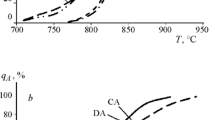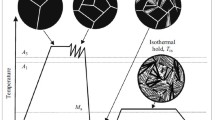Conclusions
-
1.
Stell 0Kh20N9S2BGTYu has two temperature ranges of embrittlement \t-450–650\dgC and 700–850\dgC. In the high-temperature range \gs phase is formed.
In the low-temperature range there is precipitation hardening of the ferritic component. At 500–550°C holding for 5 min results in substantial hardening and a reduction of plasticity, and therefore the temperature of the molten alkali used in pickling should not exceed 420°C.
-
2.
The electron microscopic examination of the samples tempered in the embrittling low-temperature range showed precipitates of intermetallic phase with an ordered cubic structure coinciding crystallographically with the lattice of the matrix (\ga solid solution) but with a lattice parameter (5.7 \0A) double that of the matrix.
Similar content being viewed by others
Literature cited
I. Ya. Sokol, Metal. i Term. Obrabotka Metal., No. 12 (1965).
H. Markus, J. Peistrup, and M. Fine, ASM Trans. Quart.,58 (1965).
V. M. Kardonskii and M. D. Perkas, Metal. i Term. Obrabotka Metal., No. 3 (1965).
V. B. Spirodonov, Yu. A. Skakov, and V. N. Iordanskii, Metal. i Term. Obrabotka Metal., No. 3 (1965).
Additional information
Hammer and Sickle Plant. Translated from Metallovedenie i Termicheskaya Obrabotka Metallov, No. 3, pp. 41–44, March, 1969.
Rights and permissions
About this article
Cite this article
Liberman, E.É., Sokol, I.Y. The nature of hardening and embrittlement of steel 0Kh20N9S2BGTYu. Met Sci Heat Treat 11, 206–208 (1969). https://doi.org/10.1007/BF00658734
Issue Date:
DOI: https://doi.org/10.1007/BF00658734




